Disinfection of water in a well: features of the disinfection procedure
Has the water in your well become dirty and its smell leaves much to be desired? Agree, such water is not only unpleasant to use as drinking water, but also very dangerous. After all, the microorganisms it contains can lead to various diseases.
Are you planning to disinfect a source, but don’t know how to do it correctly? We will help you understand the intricacies of this process and tell you what tools you can use. We have described in detail a set of measures aimed at eliminating unpleasant odors and pollution.
We present effective compounds used for disinfection, present thematic photos and videos with valuable recommendations. Proper and timely disinfection of water in a well, carried out according to our advice, will allow you to safely use it for drinking, household needs and irrigation.
The content of the article:
When is disinfection necessary?
Disinfection includes two stages: cleaning the mine well and water disinfection. All wells are subjected to this process, regardless of their purpose and frequency of use.
The reasons why it is necessary to carry out disinfection measures can be very different:
- flooding due to spring floods;
- infiltration of sewage or groundwater;
- penetration of agricultural or industrial chemicals;
- bodies of birds and animals falling into the well;
- intensive use of the well, resulting in subsidence of the bottom soil;
- formation of mucus, dirt, salt and mold deposits on the walls;
- presence of small debris and dust in the open well.
It is recommended to carry out preventive disinfection of the well at least once a year, and it is better to do it twice - after the spring flood and in early spring.
Remember that low-quality, contaminated water not only has unpleasant taste and smell, but is also a breeding ground for the proliferation of pathogenic microorganisms dangerous to humans and farm animals.
That is why it is necessary to regularly purify well water and mines.
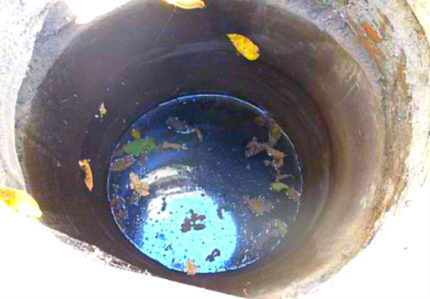
Preparation for disinfection treatment
It is recommended that preparatory work be carried out immediately before the disinfection procedure. The speed and quality of disinfection treatment largely depends on the correct preparation.
First of all, it is necessary to pump out the water. If there is little water in the well, then it will be enough to use surface pump.
If the water level is significant, then a powerful submersible pump will be required. Before starting the pump, you need to remove floating debris from the well; a long-handled net with a fine mesh is best suited for this purpose.
After pumping out the water, they descend into the well and inspect its bottom and walls for cracks, leaks, and deposits. If there are cracks they must be eliminated with a special waterproofing solution. Debris, algae, and silt are also removed from the walls of the well.
The tools used are stiff brushes and spatulas. The bottom of the well is cleared of sediment, the old bottom filling is removed as far as possible and a new one is filled in.
As bottom filling You can use fine crushed stone, gravel, sand. Expanded clay cannot be used due to its too low specific gravity and high toxicity.
If there is plaque on the concrete rings, it should also be removed. For this, various substances are used, the composition of which depends on the nature of the deposits. Salt deposits are removed with acid-containing solutions, such as a weak solution of hydrochloric acid or vinegar.
It is recommended to carefully remove corrosion stains using a jackhammer or grinder, and treat the surface with a waterproof anti-corrosion compound. If moldy deposits are present, treatment with copper sulfate is required.
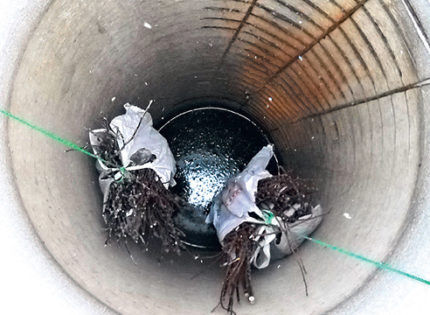
Disinfectants
Disinfection of water in a well is carried out using special agents that have antibacterial and disinfecting properties.
They must have the following properties:
- effectively eliminate pathogenic microorganisms and suppress their development
- be safe for the human body
- do not damage the walls of the well
- easy to wash off.
Most often, compounds are used to disinfect well water and mines, which we will discuss in more detail in the next part of the article. To pump out water that has undergone a disinfection procedure, it is better to use inexpensive pump, which after consumption you won’t be sorry to part with forever.
Remedy #1 - Effective Bleach
You can buy 1% chlorine powder at any hardware store.
To accurately calculate the amount of bleach, the following experiment is carried out:
- take 10 g. bleach and dilute in 1 liter of clean water;
- take 3 containers of 200 ml each and fill them with water from the well;
- add 2 drops of chlorine solution to the first container, 4 drops to the second, 6 drops to the third;
- stir the water in all containers and wait 30 minutes;
- After the time has passed, we check each container for the presence of chlorine odor - it should be barely noticeable.
Considering that 1 ml of bleach solution contains 25 drops, we find that to disinfect 1 cubic meter of well water, 400 ml of solution is needed. Knowing the volume of water in the well, it is easy to calculate the need for a chlorine solution required for the disinfection procedure.
Disinfection instructions:
- Pour the solution into the well and stir the water in it for 10 minutes using a long pole or brush. If the volume of the well is large, then it is advisable to use a bucket on a rope for mixing, which scoops up water and then pours it back.
- We cover the well with plastic film or thick cloth for 6-10 hours in the summer or for 12-24 hours in the cold season. It is important to prevent direct sunlight from entering the well, under the influence of which chlorine breaks down, significantly reducing the effectiveness of disinfection.
- If, after the specified time, the smell of chlorine is completely absent in the well, then disinfection should be repeated, because this indicates the destruction of the chlorine compound and the low effectiveness of disinfection measures.
- We wash the walls of the well first with chlorinated water and then with clean water.
- We pump out the water until you smell chlorine.
When using bleach, you must strictly observe safety precautions, avoiding contact of the solution with skin, plastic and metal surfaces.
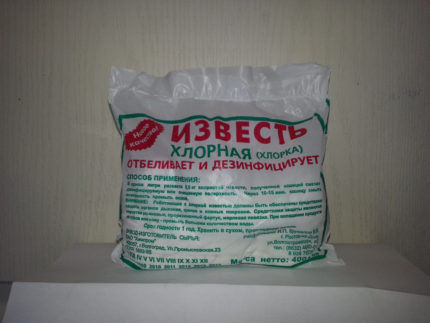
Remedy #2 - affordable “Whiteness”
Another inexpensive way to quickly and efficiently disinfect a well.It was experimentally established that the optimal concentration is 1 liter of “Whiteness” per 1 reinforced concrete well ring of water.
The disinfection technology is exactly the same as when using bleach: the solution is poured into a well, the walls are washed with a brush, a long brush, or just a rag wrapped around a pole.
Sometimes special garden sprayers are used to apply chlorine solution or “Whiteness”. This simplifies the procedure for cleaning the walls of the well, but do not forget to thoroughly rinse the equipment after finishing work.

Remedy #3 - quick and safe potassium permanganate
This method of disinfecting a well is gentle, but its effectiveness is significantly inferior to the chlorine method. However, in some cases, potassium permanganate (potassium permanganate) can be used to disinfect the mine and water in the well.
To prepare the solution, take 1 tablespoon of potassium permanganate per 10 liters of warm water. The solution is thoroughly mixed and poured into the well. Leave the solution for 30-60 minutes and pump out the water several times.
After completing the cleaning with a manganese solution, wash the dry well walls, and a mesh (ordinary sieve) with 3-5 grams of manganese is placed at the bottom, which will remain there constantly, providing a disinfecting and antibacterial effect. Instead of manganese, you can put silicon chips on the bottom, which also has disinfecting properties.
Remedy #4 - iodine solution as an emergency measure
Experts have different opinions regarding this method of disinfection.Some believe that iodine is an excellent antibacterial agent that destroys pathogenic microorganisms and the environment that prevents their proliferation.
Others say that the required bactericidal concentration will make well water unsuitable for drinking and irrigation.
In any case, disinfection with iodine can be used in cases where it is not possible to completely disinfect the well. To do this, you need to prepare a solution - 3 drops of iodine per 1 liter of water (3-5 liters of water is enough for 1 reinforced concrete ring) and pour it into the well. This measure will help slightly delay the cleaning of the well and improve the quality of the water.

Remedy #5 - tablets
The modern market for household chemicals offers a convenient option for disinfecting wells - chlorine tablets "Aquatabs", "Septolite", "Ecobreeze" and others.
The average consumption of such tablets is 4 tablets per bucket of water for one well. The exact dosage is given by the manufacturer in the instructions for chlorine tablets. To prepare solutions, use a plastic or enamel bucket; water is taken at room temperature.
The disinfection procedure is carried out in two stages:
- Preliminary stage. Water is pumped out of the well, the bottom and walls are cleaned of dirt and sediment. After this, the walls are irrigated with the prepared solution; for this you can use various spray devices or simply a rag on a pole or a brush. After applying the composition, you need to wait 30 minutes and then rinse the walls with clean water.
- Water disinfection. The well is filled with water and the solution obtained by dissolving chlorine tablets is poured into it. The number of tablets depending on the volume of the well is also indicated in the manufacturer's instructions.
To disinfect, the water in the well is mixed with a disinfectant composition, and the well is tightly covered with polyethylene or thick cloth. Aged from 3 to 12 hours. After this, it is necessary to pump out the water until the smell of chlorine disappears completely.
The use of tablets in comparison with bleach and bleach has the following advantages:
- high efficiency of cleaning and disinfection;
- ease of use, ease of preparation of the solution;
- shorter residence time of the solution in the well;
- safety of use.
The disadvantages of chlorine tablets include their high cost.
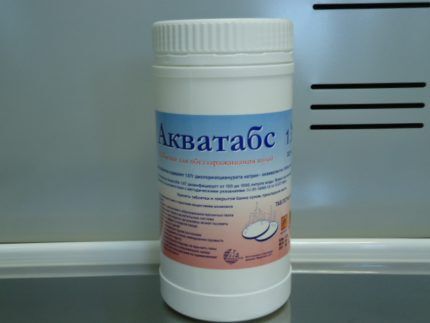
Physical methods of disinfection
Modern methods of disinfecting well water include ultrasonic And ultraviolet cleaning. Both methods are highly effective and environmentally friendly, but their implementation requires the installation of expensive equipment.
It is advisable to install such equipment if water from the well is used in the autonomous water supply system of a house with year-round residence.
The UV cleaning device is equipped with an electronic unit that automatically regulates the water supply to the cleaning unit. The emitted ultraviolet destroys all known microorganisms without changing the taste, smell and color of water.
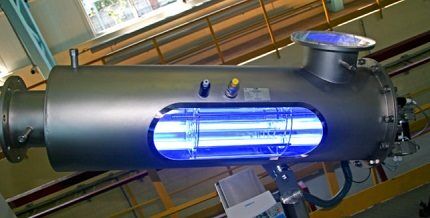
In addition to the high cost of equipment, this method has another drawback: if the well is open, there is the possibility of secondary contamination of the water.
Ultrasonic cleaning uses equipment that emits ultrasonic waves, which are also harmful to microorganisms.
Of course, these disinfection methods are considered the most advanced and safe, but their use in most farms is not yet possible due to the high cost and inadequacy of wells.
Actions after disinfection is completed
After completing the disinfection procedure, which was carried out using chlorine-containing products, it is recommended to follow the following recommendations:
- Do not use well water for the first 24 hours after disinfection is completed.
- For 5-10 days, it is necessary to boil and/or pass water from the well through a filter before use.
- If there is a smell of chlorine in the water, then it is necessary to completely pump the well.
After all these steps, it is advisable to carry out a chemical well water analysis to assess the quality of cleaning and confirm its safety.
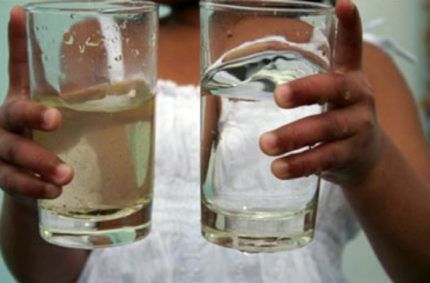
Measures to prevent source pollution
In order to carry out disinfection measures as rarely as possible, but at the same time use high-quality water, it is necessary to follow a number of measures aimed at preventing contamination of the well.
Such measures include the following:
- the well must not be left open;
- maintain a distance of at least 20 meters from the well to the sewerage and drainage system;
- reliably seal the walls of the well, preventing the penetration of groundwater;
- use submersible pumps with remote injectors, this significantly reduces the number of leaks;
- Observe sanitary standards and do not pour waste into the well.
Following these simple measures will avoid clogging and silting of the well, which are the most likely causes of deterioration in water quality.
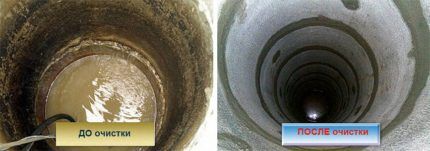
Conclusions and useful video on the topic
Video #1. A detailed story about preparing a well for disinfection, pumping out water and cleaning the bottom backfill:
Video #2. Chlorine is a substance used to disinfect well water:
Video #3. Tablets for disinfecting water in a well:
Do not neglect preventive cleaning and disinfection, which allows you to operate the well for a long time and without problems. Treatment should be carried out in a timely manner, choosing the most suitable product in your case..
If you have to carry out disinfection measures on your own, then you need to stock up on personal protective equipment, especially when working with caustic compounds such as chlorine or bleach.
We welcome everyone who wants to share their personal experience in cleaning well shafts or water disinfection and get answers to their questions to participate in the discussion of the topic. Please write comments in the block located below the text of the article.




We rented a dacha for the summer. Already when I moved my family, it turned out that there were problems with the water supply and frequent interruptions in the water supply. But there was an old well on the site. To avoid trouble (I didn’t want to pick up E. coli), I ordered ultraviolet water purification. Yes, it didn't come cheap. But as a temporary measure it’s fine. The well began to be covered with boards to prevent dust and small debris from getting into it.
If this was not your dacha, but you rented it for such a short period of time - for the summer, wouldn’t it be easier to take care of another source of drinking water, and use the well purely for household needs?
It’s quite easy to survive three months on bottled water. It will be cheaper and easier. Is it reasonable to clean a well at someone else’s dacha, which you just rented, and even in such an expensive way as ultraviolet cleaning? Moreover, this method is not very suitable for a well, which, whether you cover it with boards or not, there is still a risk of re-contamination.
We recently bought a house with a well in the yard. It was quite dirty, but we didn't use it. But when problems with water supply began, we started thinking about cleaning the well for further use. They cleaned it with bleach: of course there was a specific smell, but it quickly disappeared and there were no problems with it. I liked the result: the water in the well is mirror-like and tastes like something from a store)
Perhaps this method is suitable for disinfection, but I still would not use the water from this well for drinking and cooking.Well, or installed some serious filters, with additional disinfection (ultraviolet light, for example).
The most delicious water in Baikal. But it was sold to the Chinese.